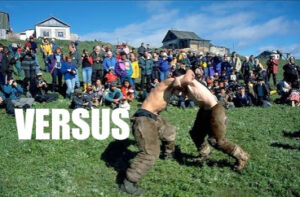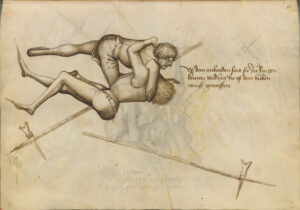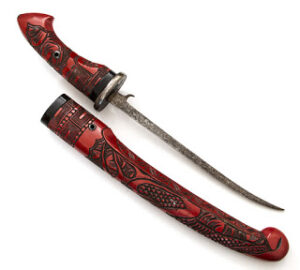I wrote this article a couple of decades ago for the Thrower list. Back then there was very little on the internet about African Throwing Knives.
African Throwing Knives

Miss Summers kindly models for us with a hammer and a Southern form of African Throwing Knife.
“African throwing knife” is a confusing term since most of these are not anything we'd call a knife, and "throwing iron" is sometimes used. The weapons are mainly used in Northern and Central Africa.
Problem is that many of them are never used as missiles or even weapons, but have symbolic/ ritual/ magical functions.
Using the African words is of little use since every tribe has a different name for them. The terms “Hunga Munga”, “Thrombash” and “K'pinga” are possibly the best known.
Throwing forms usually have an uncovered grip section or just a cord or lizard hide wrap. At least some of these knives have an aerodynamic "D" shaped section.
A typical northern form of knife is about 30" long and shaped like an "f" or sometimes an "?". The "knife" is carried sloped over the shoulder, sometimes in a sheath that holds three. These weapons have been used by both cavalry and infantry, and seem to have been the main reason leg armour was adopted for African war horses.
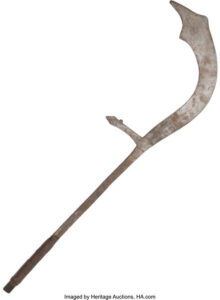

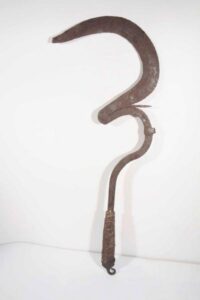
I've seen it claimed that many of these knives are used as general purpose tools for jobs such as clearing brush or butchering game. You can see these things as being awkward for some jobs and good for others and it is usually noted that many of these knives obtained for collections show no signs of the wear or resharpening you'd expect. On the other hand, man will often use the tool to hand rather than the tool for the job (I remember a nice photo in the Pitt-Rivers Museum of a guy making a pair of sandals with his spear edge).
Southern forms of knives are shorter (c 18" or less) and proportionally broader. Shape is more varied, resembling "Y", "r", "K" or branching antler-like shapes.
The elite warriors of certain tribes would carry four of these hanging on the inside of their shields.
When thrown vertically at the top of a shield they are said to somersault over and drop down onto the foe's head.
When thrown horizontally they can be bounced off the ground to take out the foe's ankles beneath his shield.
Being able to jump suddenly was a required skill of a warrior!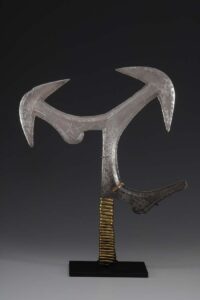
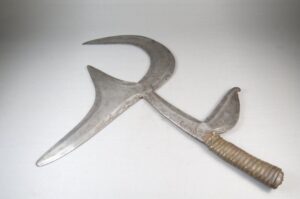




FEEDBACK
I think Phil was referring himself to an African throwing knife called "'Mbum", a middleway between the axe and the knife. Otherwise to particular "Taliks" used by Tahuas to kill the mices of the desert; or the throwing knives used by Ballegs and Vahims' tribes….
Grisonio
There's a name for these in every dialect of the North and Central Africa -not heard those ones though. Thrombash, Hunga Munga and K'pinga are some of the better known terms. If the desert tribes are using what I'm thinking of they'll be about 30" long -lot of knife for a mouse.
Phil
(Lee Fugatt) writes:
….kill mouses?? Prego Grisonio but I would love to see some one pick off a mouse with a throwing knife!!! I miss grey squirrels about half the time and kinda good at throwing stuff. Ain't saying it can't be done but I'd sure to see it!! Lee
….kill mouses?? Prego Grisonio but I would love to see some one pick off a mouse with a throwing knife!!! I miss grey squirrels about half the time and kinda good at throwing stuff. Ain't saying it can't be done but I'd sure to see it!! Lee
Tahuas'tribes are nomads who live hunting preys like mice, locusts, lizards, scorpions, snakes and coleoptera, perhaps the only animals of the desert, if we exclude the more and more rare "fennec" (little-fox). Their life depend on their throwing-skill and during hunting period they cannot miss the target. When that happens, — (and IMO it happens very seldom) — they can only say: "#@$+§*%!! bye bye dinner…" @=^)
Lee, they are "professional throwers" and don't waste their time playing with squirrels and bambi…. @=^D
Lee, they are "professional throwers" and don't waste their time playing with squirrels and bambi…. @=^D
Grisonio
P.S. = Hey Phil, one of the throwing-weapons used by mouse-hunters of Central Africa is like this…
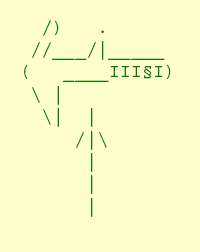

'MBUM" (Maybe you know it by a different term) is bound by a short rope utilized to set it in rotary motion.
How big is this thing and is it made of metal? It looks a lot like a southern throwing iron, though I'd expect a northern form to be in use in desert regions. When you say the rope sets it in a rotary motion -do you mean a rope is wound around to spin it like a top, or just a cord wrap handle?
Phil
Yeah, it is a sort of "ascia-falcetto" or double-scythe, but only one of the blades is sharpened. It is supplied with another short blade, a cutting tooth, near the bone handle. Length: approximately 16 cm. (blade) + 9 cm. (handle)
The cord is very short and bound near the tip of the handle. About its utilization, IMO, the African Mbum can be considered a middleway between the medieval Kusari-Gama of Okinawa and the prehistoric Bola Perdida of Peru. A similar throwing-weapon, without cord, is utilized in Central Africa by Kotos. Hope this helps.
Grisonio
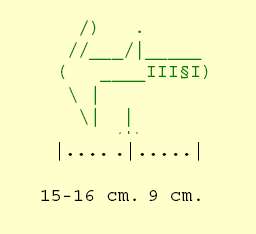
Indeed it does -what part of Africa did you say these mouse hunters were from again? This thing is smaller than a Central African (southern) thrower and way smaller than the northern forms -plus you have the additional action of the cord to whirl it by -there seems to be a real shortage on decent information on African throwing blades.
